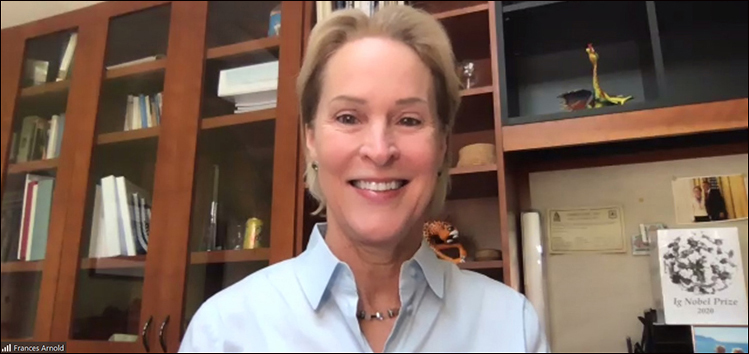
Mixing chemistry, biology and engineering, Frances Arnold tweaks enzymes found in nature to perform new tricks by altering their DNA.
Arnold, a Caltech chemical engineer with a Nobel Prize in Chemistry, scads more awards and honors, and research citations through the roof, delivered a rousing virtual lecture to some 700 listeners—almost twice. “You missed a really great lecture,” Arnold said and smiled when she learned her internet connection dropped shortly after her introduction and lasted almost 20 minutes.
Unruffled, she restarted and delivered the Vanderbilt School of Engineering’s 2020 fall John R. and Donna S. Hall Engineering Lecture Tuesday, Sept. 15. Her lecture, “Innovation by Evolution: Bringing New Chemistry to Life” is a nod to her Nobel Lecture in 2018. Arnold is the fifth woman to win the Nobel Prize in Chemistry since it was first awarded in 1901.
Arnold developed a technique in the 1990s called directed evolution that has put the power of evolution into chemists’ hands. Her pioneering work is inspired by nature, using evolution to redesign enzymes for use in biotechnology and creating entirely new dimensions to protein chemistry. Arnold calls nature “a brilliant chemist and by far the best engineer of all time.”
“Enzymes are complicated,” Arnold said. “But nature has a wonderful design process for manipulating DNA to achieve useful functions, and that’s evolution.” Arnold used the example of atrazine, an herbicide originally thought to be non-biodegradeable and ultimately banned in Europe. Some discovered organisms have evolved to degrade man-made atrazine and make a new source of nitrogen to sustain themselves.
“Scientists have used evolution to modify the biological world at the level of DNA, improving corn and making poodles,” she said, popping a slide with a photo of dogs, a white poodle in the forefront.
Arnold uses the process of evolution—mutation and natural selection—to compose new DNA in enzymes: Breed in a test tube. Make mutations. Choose the best ones. Repeat. Arnold’s lab has generated microbes that do what organisms in nature have never been known to do. She and her team reported the use of enzymes to catalyse the formation of carbon-silicon bonds, two abundant Earth elements, but such bonds are not naturally occurring. (Science, 2016)
While others have contributed to the field of directed evolution—and Arnold cites them—she developed the iterative methods that mimic the random mutagenesis and selection found in nature and developed screening techniques to select mutations for targeted properties. Also, she chose to publish rather than patent the processes so others could make new enzymes.
Arnold, the Linus Pauling Professor of Chemical Engineering, Bioengineering and Biochemistry at CalTech, has created enzymes for applications in alternative fuels, chemicals and pharmaceuticals. She has cofounded three companies that use directed evolution to create enzymes: Gevo, a producer of biofuel and chemicals; Provivi, a specialist in nontoxic pest control; and Aralez Bio, which makes unnatural amino acids.
“Instead of asking what enzymes do in the natural world, we can now ask ‘What might they do?’” Arnold said in her Nobel lecture, “A treasure trove of new enzymes awaits discovery for carrying out chemistry that we could not even contemplate just a few years ago.”
Contact: Brenda Ellis, 615 343-6314
brenda.ellis@vanderbilt.edu